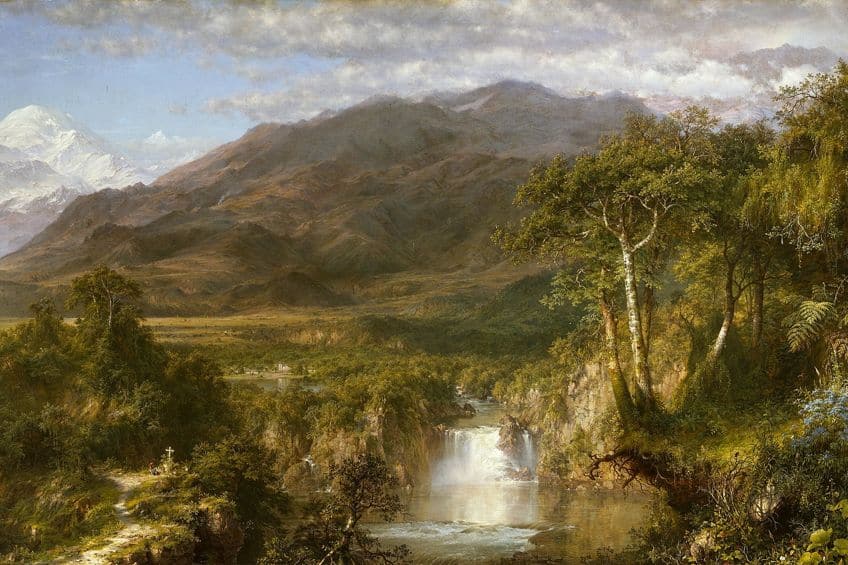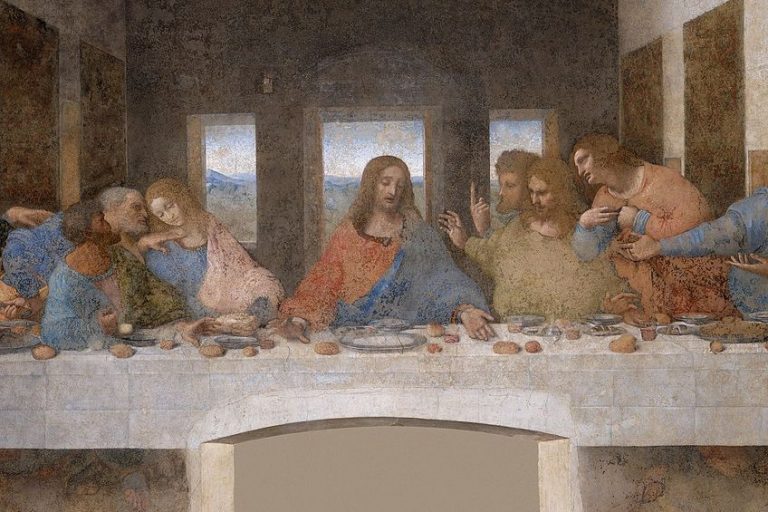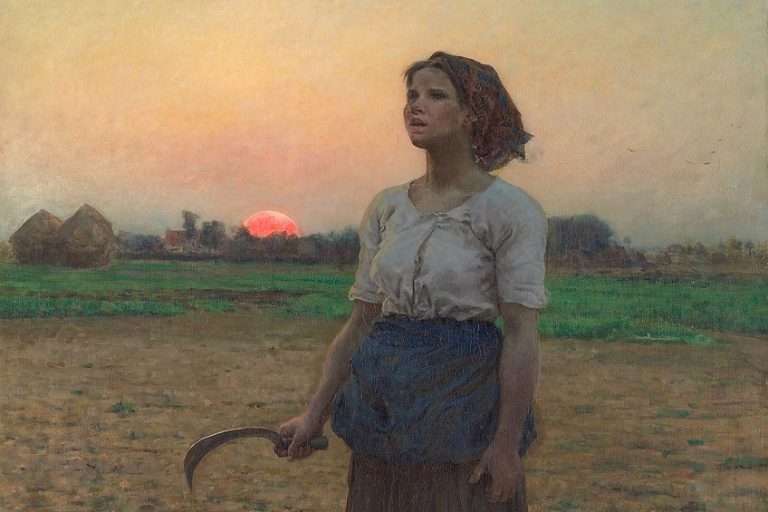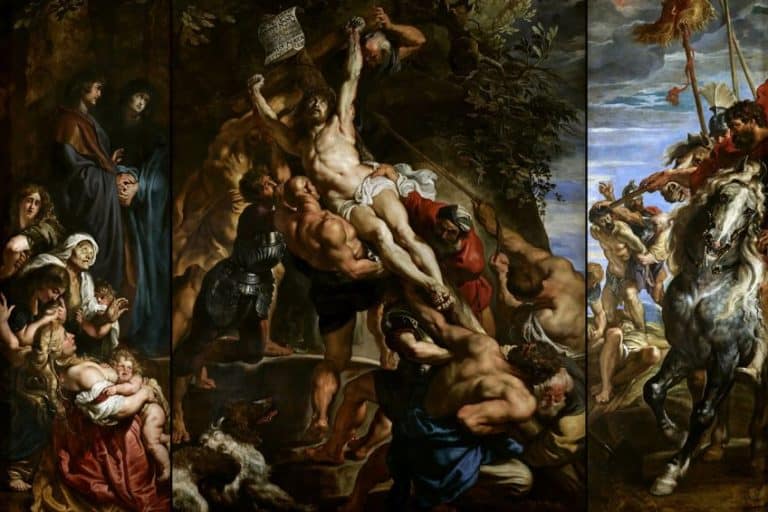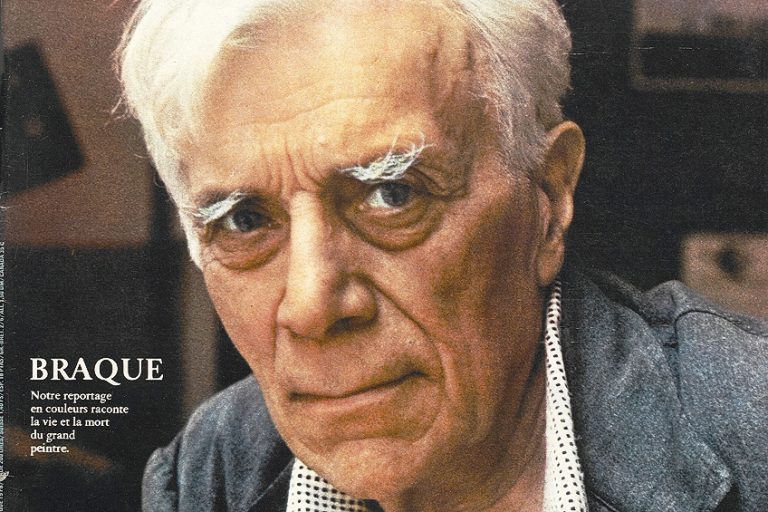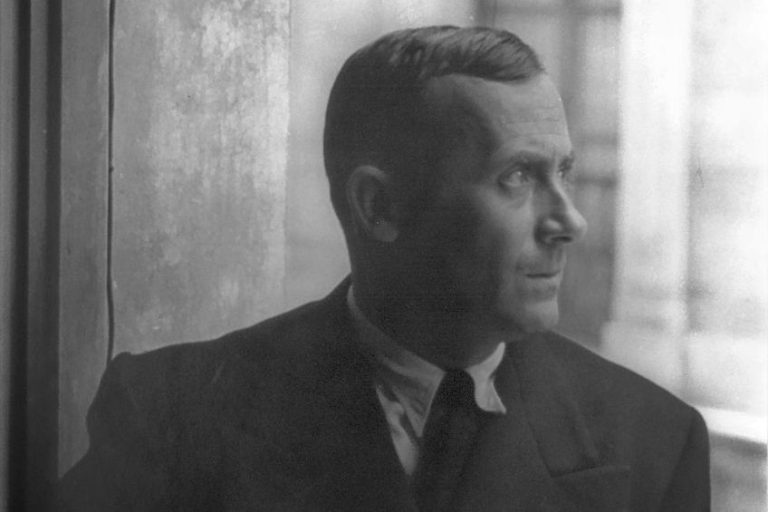“Heart of the Andes” by Frederic Edwin Church – An Analysis
Moved by the travels of Alexander von Humboldt and the artistic prowess of Thomas Cole, Frederic Edwin Church became one of the most influential leaders of the Hudson River School in the 19th century. Among his best works was a landscape painting that captures an idealized snapshot of a fictional site in South America, which eventually fell into the care of the Metropolitan Museum of Art in New York City in 1909. In this article, we will unpack key insights into this famous Church painting, including all the small and fascinating details about the painting’s subject. Read on to discover more!
Who Was Frederic Edwin Church?
What was the famous South American landscape painting created by Frederic Edwin Church, and who exactly was Church? Born in 1826, Frederic Edwin Church was a prolific American painter who hailed from Connecticut and went on to become one of the most famous artists of the Hudson River School. This movement was an influential American art movement led by Thomas Cole, and later Church, who drew influences from Romanticism to find their own style initially centered on the landscapes of the Hudson River Valley. The founding of the Hudson River School was significant since it was the first school in America dedicated to landscape painting.

Church developed his fanbase in New York, which grew his reputation and enabled him to experience much success in his artistic career. In 1859, Church displayed his famous painting The Heart of the Andes at his studio, which saw more than 12,000 visitors who happily paid the entrance fee to view his work. Church often had many successful single-artwork shows that cemented his reputation by offering viewers few yet incredibly masterful paintings of American landscapes. His value rested in his quality and ability to romanticize the environment of those who appreciated the appeal of exotic splendor, adventure, and many of the sensations that Church himself experienced from his own sources of inspiration.
Below, we will explore the many unique details about The Heart of the Andes by Frederic Edwin Church, which even managed to mesmerize the mind of Mark Twain.
The Heart of the Andes Painting by Frederic Edwin Church
| Date | 1859 |
| Medium | Oil on canvas |
| Dimensions (cm) | 168 x 303 |
| Where It Is Housed | Metropolitan Museum of Art, New York City, United States |
The Heart of the Andes painting became the most famous painting in American art circles after it sold for $10,000, making it the highest price paid for a painting to a living artist. Infused with a sense of romantic lyricism and evident exoticism of South American landscapes, The Heart of the Andes portrays the snow-capped Mount Chimborazo, which appeared frequently in Church’s paintings among the lush vegetation of a South American landscape that the artist conjured up. The site is not a real site; however, the large rocky structure is a volcano in Ecuador. There are many minuscule and remarkable details in the painting that make one buy into the idea that the landscape might be just as real as all its fine components. From the tiny cross to the flora and fauna of the scene, Church paid meticulous attention to the layout and atmosphere of this idyllic scene.
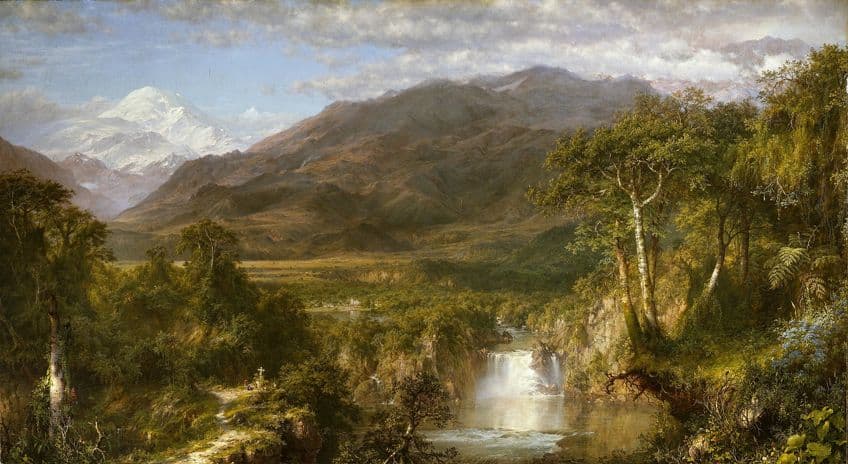
Why? Ideals also sold well. This was true in his era; however, it was largely also owed to the fact that Church’s painting style is considered technically brilliant. Furthermore, the painting was an amalgamation of landscape elements inspired by multiple topographies from the Andes Mountains, as well as the presence of human occupation and traditionally “exotic”, natural elements such as a jungle, birds, and flowers. Through the combination of these elements with his technical talents, Church sold a fictional ideal that was inspired by real-world elements, making the scene familiar and almost reachable, but still very much a dream that does not exist. One might even claim that the painting taps into the realm of the sublime and perhaps Church was the “manual version” of an AI generative artist, who melded together a picturesque image almost seamlessly.
Such is the power of the imagination.
The Context Behind The Heart of the Andes Painting
In the mid-19th century, Church ventured to Colombia and Ecuador under the patronage of Cyrus West Field, who also happened to be a founding member of the Atlantic Telegraph Company. The businessman was among the first group of innovators who laid the first telegraph cable across the Atlantic Ocean. He funded Church to create idyllic paintings for, what we would identify as, marketing; to attract clients to his South American projects.
The painting itself contains elements of the local topography that Church took note of during his time travels, including Mount Chimborazo and the glittering pool and waterfall. Traces of religion such as the cross were representative of Church’s own reference and signature since he always incorporated the presence of a church in his work. The cross in this image is believed to be of Catholic and Spanish creation, which is also inaccessible to the viewer since it is placed in a distant location, which may draw your attention to the painting’s clever and perhaps unintentional psychology.

There was no doubt that the painting had a special impact on 19th-century viewers. A witness once stated that the painting was so impactful that it made men and women fall dizzy in an expression of vertigo or perhaps terror caused by the identification of the sublime. Can one become so entranced by a false sense of nature or exposure to it that one falls victim to its overwhelming power?
The painting was exhibited between April and May of 1859 at the Tenth Street Studio Building in New York City, which was also the first building created for artists. Church charged an admission fee of 25 cents and attracted 12,000 visitors, including eager patrons who waited in line on the final day to see the work.
For the viewing, Church offered viewers opera glasses to inspect the details alongside two brochures entitled Church’s Picture, The Heart of the Andes by Reverend Louis Legrand Noble, and A Companion to The Heart of the Andes by Theodore Winthrop.
Key Influences on Church’s Work
Frederic Edwin Church was influenced by many influential figures with the most prominent being John Ruskin, who was a British critic and theorist. Ruskin’s treatise Modern Painters in particular was a popular publication for many landscape painters at the time, which was also likely to have influenced Church at some point. Similarities between Church’s painting with Ruskin’s ideas can be found in the detailed observations of nature. Ruskin identified art with nature and morality, all of which were united by spirituality. One can easily begin to spot the connections between Church’s paintings and Ruskin’s belief through the artist’s intricate work on The Heart of the Andes, which draws attention to the cohesion among the different elements. Church’s intellectual inspiration was also stimulated by the journeys and experiences of Alexander von Humboldt, as well as Thomas Cole’s passion for landscape painting.

Interesting Details in The Heart of the Andes Painting
There are many fascinating points of discussion in the painting that make it a unique artwork. Apart from the technical splendor of the painting and its vivid appeal, the idyllic landscape was created to immerse the viewer in this world. To sell South America to the viewer while highlighting details that beg one to spend more time contemplating the symbolic and psychological nature of the work. Themes of human presence are at the forefront of this ideal scene, which alongside the monumental Mount Chimborazo, leads the viewer through color contrast between the shaded slopes and the brightly colored vegetation. The presence of a worn-out path directs our attention to human presence, time, travel, and occupation.
A pathway is also strategically used to lead the way to “opportunity” and embeds a message of intrigue fueled by the desire to explore such a foreign landscape.
Church also signed his work by including a painted signature carved into a tree, which doubles as a symbol of man’s ability to somewhat “conquer nature” or tame it. What makes this stand out is the poor health of the tree in contrast to the vibrancy of the jungle around it. In the near foreground, one also spots two figures, assumed to be locals of the area, appearing before the cross. Another great contrast tool was the use of irregular and smooth forms that add visual interest and keep the engagement sustained. Through such strategies, one can agree with the theorist William Gilpin that the painting mirrors the harmony found in nature and conforms to aesthetic principles.
Legacy of The Heart of the Andes by Frederic Edwin Church
After the painting’s success in New York, it had traveled across multiple destinations for exhibition and when it reached London, it was decided that the painting would be reproduced as an engraving by Charles Day & Son. It was during this period, in the 1850s, when a watercolor copy of the painting was created, presumably by Richard Woodman or a relative, however, the identity of the artist remains unknown. The famous copy of The Heart of the Andes (1859 – 1860) remains in the collection of the National Gallery of Art in Washington, D.C. In addition to the mystery around the copy, the original painting along with its influence and legacy was captured by many creatives, including the composer George William Warren and Mark Twain.

The painting was sold to William Tilden Blodgett with a condition that he would re-sell the work should it fetch a minimum price of $20,000. Margaret Worcester Dows acquired the painting after Blodgett’s death and bequeathed it to the Metropolitan Museum of Art. Not only did the museum attempt to recreate the original conditions of Church’s exhibition, but the widespread recognition of the work also helped stimulate the discourse around American territorial expansion.
The Heart of the Andes by Frederic Edwin Church leaves much to aspire toward and consider when it comes to navigating how one can transform a landscape into an artwork of great influence. With Church’s example, one can also explore the complex themes of territory, political and military expansion, as well as the bridge between natural science and art to critically engage with landscape art.
Frequently Asked Questions
Who Painted The Heart of the Andes?
Renowned American landscape painter Frederic Edwin Church painted The Heart of the Andes (1859). Church was an important figure in the Hudson River School, who was inspired by Thomas Cole, the school’s founder, as well as Alexander von Humboldt and John Ruskin.
Is the Landscape in The Heart of the Andes Real?
The landscape in The Heart of the Andes (1859) painting by Frederic Edwin Church is not real since it represents multiple elements derived from Church’s travels across Ecuador and Colombia. The painting is an idealized landscape containing multiple natural elements inspired by different sites, some of which were presumably made up by the artist.
Where Is The Heart of the Andes?
The Heart of the Andes (1859) is located at the Metropolitan Museum of Art in New York City. The painting was bequeathed to the institution in 1909 and has since remained part of its collection.
Jordan Anthony is a film photographer, curator, and arts writer based in Cape Town, South Africa. Anthony schooled in Durban and graduated from the University of the Witwatersrand, Johannesburg, with a Bachelor of Art in Fine Arts. During her studies, she explored additional electives in archaeology and psychology, while focusing on themes such as healing, identity, dreams, and intuitive creation in her Contemporary art practice. She has since worked and collaborated with various professionals in the local art industry, including the KZNSA Gallery in Durban (with Strauss & Co.), Turbine Art Fair (via overheard in the gallery), and the Wits Art Museum.
Anthony’s interests include subjects and themes related to philosophy, memory, and esotericism. Her personal photography archive traces her exploration of film through abstract manipulations of color, portraiture, candid photography, and urban landscapes. Her favorite art movements include Surrealism and Fluxus, as well as art produced by ancient civilizations. Anthony’s earliest encounters with art began in childhood with a book on Salvador Dalí and imagery from old recipe books, medical books, and religious literature. She also enjoys the allure of found objects, brown noise, and constellations.
Learn more about Jordan Anthony and the Art in Context Team.
Cite this Article
Jordan, Anthony, ““Heart of the Andes” by Frederic Edwin Church – An Analysis.” Art in Context. February 6, 2024. URL: https://artincontext.org/heart-of-the-andes-by-frederic-edwin-church/
Anthony, J. (2024, 6 February). “Heart of the Andes” by Frederic Edwin Church – An Analysis. Art in Context. https://artincontext.org/heart-of-the-andes-by-frederic-edwin-church/
Anthony, Jordan. ““Heart of the Andes” by Frederic Edwin Church – An Analysis.” Art in Context, February 6, 2024. https://artincontext.org/heart-of-the-andes-by-frederic-edwin-church/.


